In astronomy, stellar classification is the means of categorization for different types of stellar objects. This can range from stars themselves, to black holes to brown dwarfs. Every space traveler is familiar with the means through which to identify stars based on their color and their temperature. In stellar science, the spectrum of stars can help determine which planets may be suitable for colonization in the future. The stellar chart composes of stars that go in the order of their heat output which is as follows: M, K, G, F, A, B, and O, with M-class stars being the coolest as well as the least luminous, with O-class being the hottest and most luminous. In addition to the main sequence, there are stars that do not conform to the standard structure. D, N, H, S, C, N, L, T, and Y. All of these objects produce some degree of heat, some greater and lower than that of the main sequence.
This sequence of stars appears to be more or less universal, though in different EUS spaces, exotic types of stars also exist with elements unique to that universe. Stars of their type would either be completely impossible or unstable in the Home Universe.
Classification[]
The means through actually clarifying which categories these stars belongs in are as follows.
Color[]
Determined by temperature, from coolest to hottest: M, K, G, F, A, B, O. Humorously, a way of remembering these classes can be done through the phrase 'Oh Be A Fine Girl, Kiss Me'.
Heat[]
Also known as a spectral subclass. These can be used to clarify just how hot a star is. These numbers range from 0, being the hottest to 9, being the coolest. The star Sol is classified as being a G2 type star, meaning that it is one of the hotter classifications of G-class star.
Luminosity[]
The factor that determines just how bright a star is. Usually this goes along with aspects such as heat and color. These can be classified as such:
I - Supergiants
II - Bright Giants
III - Regular Giants
IV - Subgiants
V - Main Sequence Star
VI - Subdwarf
VII - White Dwarf
As an example of all of these factors put together, when the star Sol is analyzed, its full stellar class is that of a G2V star. So, looking at what is listed above, the class 'G' represents the star's color of yellow, which is technically also its temperature as will be listed in the lower sections. Its heat type is '2' meaning that it is one of the hotter of its class, and the luminosity class of 'V' means that it is a main sequence star, which is where many stars in their youth are.
Another example would be an M9III star. Using the same method as shown above, the stellar color is 'M', meaning the star is red. The heat subtype is listed as '9', meaning that the red dwarf is one of the coolest of its type, and the luminosity type of 'III' means that the star is a giant. Using this, an amateur astronomer can conclude that this red dwarf is near the end of its life and will blow off its outer layers to form a planetary nebula.
Main Sequence[]
These stars are ordered in the order of their luminosity as well as surface temperature.
M-Class (Red)[]
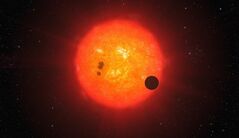
These stars are characterized by their deep red glow, and very low surface temperatures in comparison to larger stars. In general, M-class dwarfs have a surface temperature of lower than 4,000 Kelvins. In addition, their luminosity is less than a tenth of that of Sol. Some red dwarfs only have a luminosity of 1/10,000th that of Sol. In most cases, M-class dwarfs are outshone by other brighter stars. The closest star to Sol is a red dwarf, Proxima Centauri. Red dwarfs compose the largest number of stars in the Milky Way galaxy and quite likely the universe. Because of their low temperature and in turn their fuel consumption, M-class stars have lifespans postulated to last ten trillion years if not more. M-class stars also have the potential to support life, though planets in the habitable zone have a tendency to be tidally locked to their star.
K-Class (Orange)[]
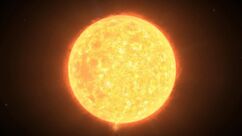
K-class stars are orange in color which makes them hotter and brighter than M-class stars but they are still dimmer than stars like Sol. The surface temperature of K-class main sequence stars hovers between 4,000 and 5,000 Kelvin. Though classified as being orange in color, K-class stars can range from bright orange to bright red. K-class stars have a good chance of supporting planets that can support Earth-based life, though they are in far less abundance than M-class stars.
G-Class (Yellow-White)[]
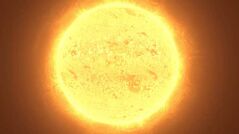
G-class stars are of the same type as that of Sol, the parent star of the planet Earth. They are considered an average type of star that are not in incredible abundance nor are considered some of the brightest nor the hottest. The fact that a G-class star hosted life on Earth has made them a frequent target for early attempts to locate Earth-like worlds. These stars tend to have surface temperatures of around 5,000 to 6,000 Kelvin and their color is frequently made to be yellow, though some stars, Sol being one, tend to be closer to white in color, though they do have a distinctly yellowish tinge to it. These stars tend to have a lifespan of about ten billion years, though their increased temperature can cause previously livable areas of a system to become uninhabitable as the star ages.
F-Class (White)[]
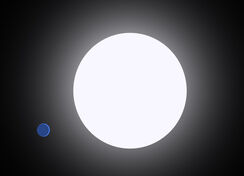
F-class stars are considered one of the last of the mid range of the Main Sequence. These are quite brighter than all of the previous star classes, though mass-wise they are close to G-class. The temperature of F-class stars can be around 6,000 to 7,500 Kelvin, meaning that an Earth-like planet that that is at one astronomical unit will not be habitable in the same position around an Earth-like star. These stars tend to be between 1 and 1.4 solar masses.
A-Class (White-Blue)[]
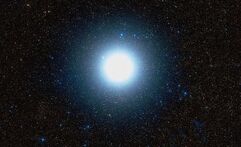
A-class stars are starting to head towards the higher scale of the Main Sequence. They are technically still dwarf stars even though they can be up to two times the mass of stars like Sol. At this point, temperature starts to increase greatly. A-class stars can rise to surface temperatures of 7,600 to 11,600 Kelvin. A-class stars have been noted to have natural Earth-like worlds around them, but these examples are exceedingly rare. The amount of radiation coupled with the age of such stars means that any planet that naturally supports life similar to Earth is unlikely to occur. A-class stars are quite young and are likely at the beginning of their lives. However, A-class stars tend to have many planets of higher mass and these tend to form large gas giants. A-class stars also have a higher chance having multiple orbiting sibling stars. Despite their size and mass, these stars still typically go nova instead of supernova.
B-Class (Blue-White)[]
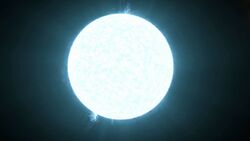
Blue class stars are still somewhat in the same league as A-class stars, but they begin to become far hotter and far more luminous than the other stars in the Main Sequence. Stars of this class tend to be quite young and have lifespans far shorter than stars in lower classes. The surface temperature of B-class stars is between 10,000 and 30,000 Kelvin. Their solar masses can also reach upwards of 16 times that of Sol. This means that B-class stars are capable of going supernova. While smaller mass stars go through an event blowing off outer layers of gas in a relatively peaceful process leaving behind a white dwarf, stars of this mass and higher go through a 'supernova' The massive weight of the star collapses the core upon death, upon which the reaction of the collapse will release massive amounts of energy that blasts the outer layers of the star off in a massive 'explosion'. The particular type of supernova caused by this class of star and higher is known as a Class II Supernova, which is caused by gravitational collapse. These stars can either leave a neutron star or black hole upon death, depending on mass.
O-Class Star (Blue)[]
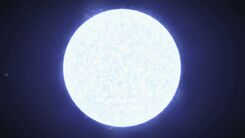
Bright blue O-Class Main Sequence Stars are young, hot, incredible massive, and are some of the most luminous stars in the whole galaxy. These stars are known for their beautiful shine as well as their incredibly high surface temperature which can be between 30,000 and 60,000 K. This incredibly high surface temperature is coupled with an incredibly high mass which can reach up to 90 times that of Sol. Their lifetimes are measured only in the tens of millions with estimates reaching between 1 and 10 million years. O-class stars always end in supernova due to their heaviness, and because of their short lifespan, if planets do form, it is impossible for life to develop on such a world - the lifespan of the star will prevent such a planet from even becoming geologically stable let alone capable of harboring even simple life. These stars are incredibly rare, but their luminosity makes the quite noticeable from a distance; O-class stars can reach luminosity levels ranging from 30,000 to 1,000,000 times the brightness of Sol, meaning that in their 10,000,000 year lives, their brightness far outshines that of the G-class star that Earth orbits.
It is theorized in the early days of the Universe that nearly all stars were of the O-class due to the high abundance of matter that remained after the conflict of matter and anti-matter roughly 200 million years after the Big Bang. These stars burned brightly, were likely a far deeper shade of blue, were incredibly hot, and upon death, created nebulae that would go on to help form their modern descendants. As the universe ages, O-class stars will probably be the first class to disappear as gas levels will eventually prevent their creation.
Giants and Stellar Death[]
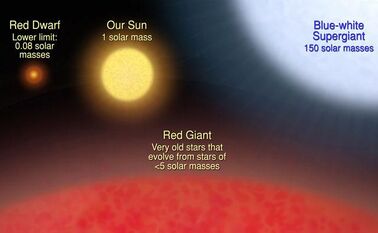
Most stars go through aging processes where most of their fuel is used up and converted into heavier elements, As a result, more pressure is put on the core. In return, these stars tend to grow very large due to the increased amount of fusion occurring. The outer layer of the stars cool and expand outwards, ballooning the radius of the star out to multiple times where it would have been in its youth. Usually, stars like this are at the end of their lives and are close to dying either through a relatively peaceful planetary nebula or a violent supernova.
Stars of any class can become a giant or a supergiant. For example, an M-class star can become a giant or a supergiant, and there are many examples of it. Betelgeuse is one of the prime examples of an M-class giant star bearing the stellar classification M1Ia. The 1 indicates that the star is one of the hottest of its class, relative to other stars, and the Roman Numeral I, indicates that the star has reached a supergiant stage specifically.
In giants and supergiants, there exists further classification that can help determine just what kind of giant the star is. These are known as type a, and type ab, and type b.
Type Ia supergiants are extremely luminous and can be visible for hundreds if not thousands of lightyears. Betelgeuse is located 437 lightyears from Sol and it's still quite noticeable in the constellation of Orion. These are sometimes known as Type 0 supergiants.
Type Iab supergiants are more or less considered normal for their size and temperature. Many stars of this size and heat reside at the Type Iab level.
Type Ib supergiants are at a far lower level of heat than other stars. Some variable heat and brightness supergiants move between Type Ia and Type Ib throughout their supergiant phase.
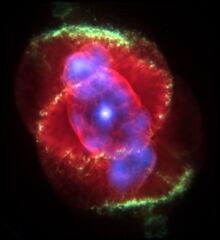
A planetary nebula - the nicer way to go.
Depending on the mass of the star, the star will undergo a death process that will fall into one or two categories. The commonly accepted level for dividing these two forms of death is divided at eight solar masses, or mass equal to that of Sol. If the mass of the star is below 8 solar masses, it will end its life in what is called a planetary nebula. When the star ages, nuclear fusion uses up all of the light elements such as hydrogen, converting it into heavier elements. Fusion of heavier elements causes pressure to form on the core, which creates hotter temperatures and more energy. The outer layers of the star puff out, becoming larger and cooler, but for now the gravity holds all of the layers together. Eventually, the collapse of the core from such pressure blows outer layers out in a relatively peaceful death, leaving behind the hot core of the sun, which is known as a white dwarf.
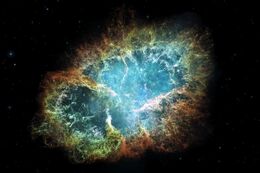
Supernova remnant known as the Crab Nebula. The evidence of an explosion is evident when compared to the planetary nebula.
If the star is above eight solar masses, the same general effect happens to a point. A star continues to grow and balloon out increasing in temperature as well as radius, but as the core collapses, the similarities end. The gravitational forces collapsing the core of the star creates a resulting explosion so powerful that it pushes the outer layers off of the star in an incredibly violent reaction known as a supernova. The still hot gasses travelling at relativistic speeds severely damage a star system. It is possible for planets to survive a supernova, but any life on their surface is likely to be sterilized. In addition, supernovae may have an effect on star systems within a thousand lightyears, though no effects have ever been experienced first hand. Gamma ray bursts from nearby supernovae are believed to have causes mass extinctions in the past.
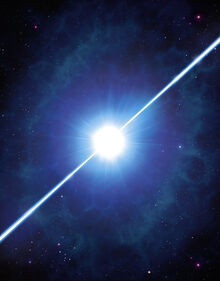
The hypernova produces gamma ray bursts similar to this.
There is a type of supernova that involves the usage of a white dwarf. As stated above,a white dwarf is what remains of a star that becomes a planetary nebula. If a white dwarf steals material from a larger orbiting star, there is a chance that it may trigger runaway nuclear fusion, causing the white dwarf to go supernova, despite being past the point of its own death. This sudden increase in temperature is too much for the white dwarf to bear, and it explodes with its matter accelerated to 6% the speed of light with the force of a regular high mass explosion. This is known as a Type Ia supernova.
One last form of stellar death exists, and it is considered the most catastrophic of the options. This is a hypernova, which results from extremely high mass stars dying and releasing superluminous supernovae. Hypernovae are believed to be the origin of long-term gamma ray bursts that last longer than a few seconds. These can be enough to sterilize a world if an unfortunate planet is caught in the crosshairs. Hypernovae are believed to have caused a mass extinction on Earth 440 billion years ago.
Carbon Stars and S-Stars[]
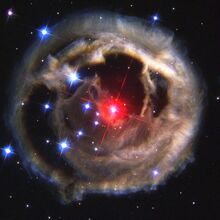
Carbon stars are at the later point of their lives and tend to be very large, easily close to giant size. What makes Carbon stars so unique is that as their name suggests, these types of stars have high degrees of carbon within their atmosphere. While the atmosphere of a carbon star does also contain oxygen, carbon runs rampant. Carbon monoxide is a common compound around these stars, and the color of such stars tends to be a very deep red, past magenta. Such stars are very cool, with surface temperatures of around 2,300 Kelvin. Atmospheres of these stars are dusty and dirty with carbon, giving it a smoky appearance almost.
Another type of star that is classed similarly to a Carbon Star is an S-Star. These types of stars have equal amounts of carbon and oxygen in their atmosphere, but what makes S-Stars distinctive is that they have high levels of Zirconium in their atmosphere, which leads to their other name: Zirconium Stars. These stars have surface temperatures that are comparable to K-class stars.
Sub-Stellar Classes[]
Brown dwarfs are sub-stellar mass objects that blur the line between extremely large gas giant and star. Brown dwarfs are believed to be failed stellar candidates that could not achieve a great enough mass to achieve nuclear fusion. These stars do not emit visible light in the same way that true stars do, instead emitting light in the infrared range. Most hotter brown dwarfs do give off a dull red glow. They range from the Late-M-class L-class, T-class, and Y-class, with the Y-class appearing more as large gas giants and Late-M-classes being nearly large enough to be true M-class stars.
Brown dwarfs have been rarely shown to support life. For an Earth-like world, the orbiting distance to a brown dwarf is extremely close in order to take advantage of the heat produced by the object. If the brown dwarf is warm enough, the planet can be lit by the dull light produced by the friction of the material in its atmosphere. These planets also have strong magnetic fields to block radiation thrown off by the host body.
Y-Class (Ultra Cools)[]
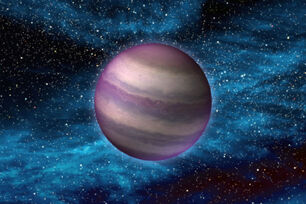
A Y-class brown dwarf looks quite similar to a large gas giant.
Y-class brown dwarfs are the smallest class of brown dwarf. Y-class dwarfs are much more likely to represent very large gas giants over they hotter and more massive counterparts. Their surface temperature can be as high as 800 Kelvin, though some of the coldest Y-class dwarfs can reach temperatures as low as 200 Kelvin. The lowest recorded temperature on Earth has been charted at 184 Kelvin, or -89.2 degrees Celsius. These bodies are more massive than Jupiter though Y-classes can be of the same mass. Some are as massive as ten times that of Jupiter and sometimes more. Y-class dwarfs have no internal source of energy, and emit very little visible light, if not a small glow from the heat produced by the atmospheric friction.
T-Class (Methane Dwarf)[]
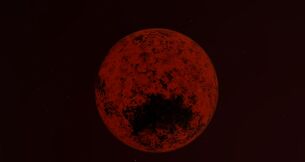
A T-class brown dwarf may show greater evidence of heat convection in its atmosphere.
T-class brown dwarfs are somewhat hotter than Y-class Ultra Cool dwarfs and are believed to be the color of dark magenta instead of Y-class dwarfs which are believed to look more like Jupiter. When viewed with some form of light reflected off it, an observer would note that surface activity is far more energetic, indicating that the heat of the inner workings of the dwarf allow for more convection, even though the T-class is still far too light in mass to provoke nuclear fusion.
T-class dwarfs are also called Methane Dwarfs due to the high level of methane that stands out in spectrometer scans. Temperature of brown dwarfs varies from around 700 Kelvin to 1300 Kelvin. For a comparison, the lowest temperature for the flame of a candle is approximately 1350 Kelvin. Dull glowing is a common source of light but as with all brown dwarfs, the lack of nuclear reaction occurring in their cores means that they do not produce their own light.
L-Class (Dwarf Star)[]
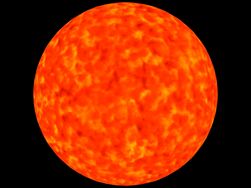
L-class dwarfs are some of the hottest of the sub-stellar dwarfs.
L-class dwarfs are cooler than M-class dwarfs, and although still considered a sub-stellar object are the closest things that can reach the traditional main sequence. These objects tend to have a red-brown color to them. L-class dwarfs have surface temperatures between 1300 to 2000 Kelvin, making them, at their warmest, still half as hot as the coolest types of M-class Red Dwarf stars. Despite being called dwarfs, they can reach incredible sizes, sometimes much larger than that of a G-class star like Sol. There has been evidence of L-class supergiants that undergo a similar process to a nova.
Late M-Class[]
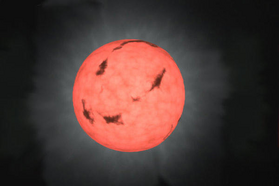
Though not in the main sequence of stars, some brown dwarfs belong to the M-class. This does not mean that the brown dwarf is capable of nuclear fusion, but that the surface temperature may be high enough to give off a stronger red glow. As it is not a true star in the strictest sense, surface temperatures of Late M-class dwarfs are well below that of true red dwarf stars, likely less than 4000 Kelvin. M class brown dwarfs are thought to be quite young in comparison to the other classes, not far from the point of formation. M-class brown dwarfs are at the pivotal moment where mass determines whether or not the object becomes a star or not.
Non-Sequence Object[]
The term 'Non-Sequence Object', abbreviated as NSO, is a type of stellar body that does not conform to the aforementioned classifications. These objects are sometimes considered post or pre-stellar objects, meaning that some are at the beginning of their lives versus others past the point of stellar death.
TT-Class (T Tauri Star)[]
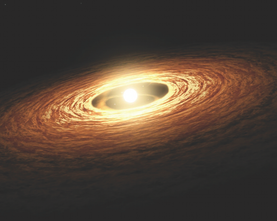
The T-Tauri star, also known as a 'protostar' is a stellar object at the very beginning of its stellar life. These types of stars are located in vast gaseous structures known as proto-planetary disks which circle the forming star as it undergoes cycles of gravitational contractions. The young star attracts hot gas and dust while compacting it into its stellar frame. Eventually, these stars will reach the point where nuclear fusion occurs, lighting the star up as it begins its life proper. The age of T-Tauri stars varies as each star tends to ignite at different times, but in general, these stars tend to be somewhere at or less than half a billion years old depending on their size and mass. Their surface temperatures are comparable to the stars they will eventually become, roughly around 4,000 Kelvin.
T-Tauri stars are generally so young that planets themselves may not have completely formed yet. Life itself is unable to form in such a chaotic system as constant bombardments may prevent even simple life from forming. In addition, planetary bodies that aren't in the process of intercepting solar system material like asteroids or other proto-planets may have surfaces far too hot to form the organic compounds for life.
N-Class (Neutron Star)[]
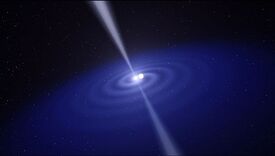
A neutron star is one of the potential remains of a star that is many times that of the sun. In short, neutron stars are stellar remains that are left behind when a star of sufficient mass goes supernova, collapsing the core and blasting off the outer layers of stellar material in violent explosions. The remaining core has been collapsed down to the point where it has not turned into a gravitational singularity like a black hole, but instead a very small and very hot point of material that spins very rapidly and emits beams of matter at a high percentage of the speed of light called relativistic jets. Neutron stars can spin at variable rates which are affected by the rotational speed of the star before death and even by the explosion itself. This spinning can be so accurate that navigational computers use quickly rotating neutron stars as navigational references. The Voyager 2 probe launched in 1975 included a map of the Sol system placed in reference to neutron stars in the local area. Neutron stars are exceptionally dense with a single thimble of their material weighing millions of tons. They are also very small, with many neutron stars only being a dozen kilometers or so in diameter.
A very notable form of neutron star that has become famous for their properties are known as 'pulsars'. While all neutron stars rotate to some degree, pulsars rotate to an extreme level and their rotations can be measured by the radio waves they emit and can be timed to an accurate level. One of the most famous pulsars in the galaxy is the Vela Pulsar located in the Crab Nebula. This pulsar rotates 11 times per second. The fastest known pulsar in the galaxy is PSR J1748-2446ad, which rotates 716 times per second. The surface of this pulsar moves at 24% the speed of light.
Another type of neutron star is a magnetar. This type of stellar remnant has an exceptionally strong magnetic field that forms around the star itself. The conditions of the stellar collapse cause the star to form what's known as a dynamo creating a massive magnetic field that surrounds the magnetar in addition to the relativistic jets. These fields tend to decay after 10,000 years.
H-Class (Black Hole)[]
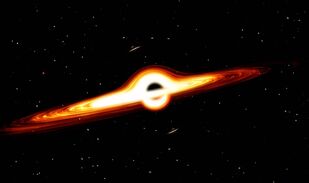
Black holes are the second class of stellar remnant to be the result of a supernova. As with neutron stars, stars that produce these are at least eight times the mass of the sun. Upon death which results in a supernova, stellar collapse occurs, but instead of creating a neutron star, the core is compacted to such a degree that a depression in space-time is formed, called a black hole, sometimes called a singularity. Black holes are named such because of their ability to entrap anything that crosses its path, even light. Nothing can escape its border, called an event horizon, once it is passed. They themselves have no color as nothing reflects off it, instead staying locked within their infinite density.
Since they emit no light, black holes are spotted by two methods. The first is if the black hole is feeding, in which it can be located due to an accretion disk - stellar material in orbit around the black hole that is devoured upon entering the event horizon. The heat of the event lights up the accretion disk, making the black hole visible ironically by making everything but the event horizon very visible. Relativistic jets will form as some material is blasted away from the black hole, sometimes for light years.
The second method of locating a black hole is if the object is not feeding. The only way to locate it would be through its gravitational lensing. It should be noted that any high mass object will lens light, that is bend light around it because of its mass. Black holes will do this to a massive degree, causing things like the galactic disk to become a ring around it. Stars will become stretched and blurred, and the event horizon can be located to some point. However, the actual boundary will not be visible unless very close. The actual number of these types of black holes are unknown, as they give off no light and may be moving in interstellar space.
A common misconception is that a black hole will pull anything towards it regardless of location. While this can be true if orbiting beyond a stable point, orbiting a black hole is actually quite possible and has been done on many occasions, as long as a ship is located in what is known as a Green Zone, at which orbiting is done in the same method as a planet or star. In a Yellow Zone, which at this point is known as a Danger Zone, orbiting can be accomplished, but only if thrusters are constantly applied. A Red Zone is a Death Zone. At this point, the object trapped will be beyond escape but it has not hit the event horizon. Instead, it will arrive at what is known as a Photon Sphere, where light has become trapped for all eternity. Here, it will be possible to see the back of one's own head as light from your back will be curved around the black hole to reach the eyes.
Once the event horizon is hit, the unfortunate piece of matter is stretched by tidal forces so that it becomes much like a piece of spaghetti as it is pulled into the infinite denseness of the black hole.
A very important type of black hole is called a supermassive black hole that can be several tens of thousands the mass of the sun. These types of black holes are commonly located in the center of galaxies, such as Sagittarius A*. These are believed to be the gravitational anchors of all massive galaxies.
D-Class (White Dwarf)[]
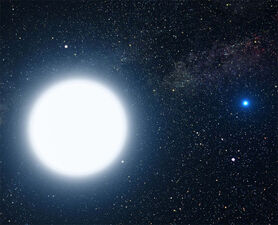
White Dwarfs are stellar remnants along with black holes and neutron stars, but unlike the latter two objects, white dwarfs tend to form from stars that form planetary nebulae, not supernova. These stellar deaths are relatively calm in comparison to larger alternatives. outer layers of gas and dust are blown off, but with nowhere near the same ferocity as a supernova. The surviving core of the star is small, hot, and very dense, and will often have a very strong magnetic field and will even have jets forming from the poles, blowing some of its matter into space. Younger white dwarfs may have planetary nebulae around them formed from the stars they were once inside. Sometimes white dwarfs will even have a system around them that survived the death of its star.
White dwarfs are massive and may have some lensing to them because of their heaviness. They are also extremely hot, sometimes being well over a 100,000 Kelvin. If a white dwarf is gathering material around it, it may become even hotter. These stars cool down over time as they are not sources of energy, rather just radiating the source of heat. Eventually, these stars will cool down into what's known as a black dwarf. No black dwarfs are known to exist as the Universe is not old enough to have them in any real number. Their lifespan is thought to be in the trillions of years as the atomic degeneration within the star means that they will slowly age and decay until they become black dwarfs.
There are multiple subtypes for white dwarfs depending on which element is common in their atmosphere. For example, a DA-Class may have no large presence of metals in their atmosphere, while a DC-Class may variable absorption lines in its spectrum, while a DQ-Class may have large quantities of oxygen in its atmosphere. A DV-class is a white dwarf of variable brightness.